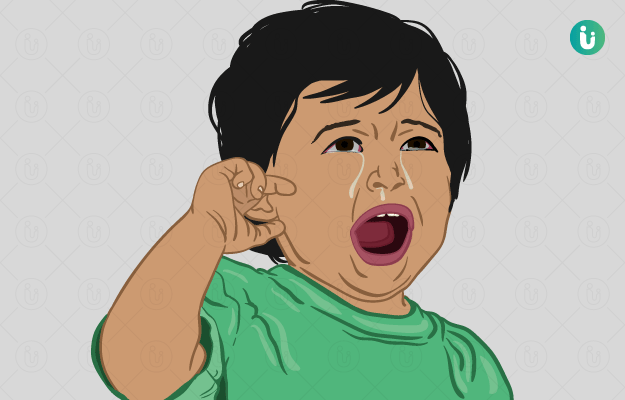What is Ear Infection (otitis media)?
Otitis media is the infection of the middle ear, which causes inflammation and a build-up of fluid behind the eardrum. It may occur as a result of common cold (nasopharyngitis), sore throat, or respiratory infection. Although the infection can develop across age groups, infants between six and 15 months of age are most susceptible. About 75% of children experience at least one episode of ear infection before they are 3 years old. The types of otitis media are as follows:
- Acute otitis media
- Otitis media with effusion
- Chronic otitis media with effusion
What are the main signs and symptoms?
Usually, in acute otitis media, the symptoms of middle ear infection develop rapidly and resolve in a few days. The key symptoms include
- Earache
- Fever
- Feeling sick
- Weakness
- Slight hearing loss – If fluid accumulates in the middle ear, hearing loss may be experienced (glue ear).
Occasionally, a perforated eardrum may develop (hole in the eardrum), and pus may drain out of the ear. Other symptoms that a child might have an ear infection include
- Pulling, tugging, or rubbing the ear(s)
- Irritability, poor feeding, or restlessness at night
- Coughing or a runny nose
- Diarrhoea
- Indifference to faint sounds or other signs of trouble in hearing, such as inattentiveness
- Loss of balance
The symptoms of infants need to be monitored closely, as they may not be able to express as effectively as older children.
What are the main causes?
A common cold sometimes leads to the build-up of mucus in the middle ear, and hence the Eustachian tube (a thin tube that runs from the middle ear to the back of the nose) becomes swollen or blocked. The infection easily spreads into the middle ear, as the mucus does not drain appropriately. Younger children are particularly vulnerable to middle ear infections due to the following reasons:
- The Eustachian tube is smaller in children as compared to adults
- A child's adenoids are relatively larger than those of adults
- Certain conditions also increase the risk of middle ear infections, including
- Cleft palate – A type of birth defect in which a child has a split in the roof of their mouth
- Down's syndrome – A genetic condition that characteristically causes a certain level of learning disability and a range of abnormal physical features
How is it diagnosed and treated?
Most cases of otitis media do not require a visit to the doctor, as it may clear up within a few days. However, if the symptoms worsen, a middle ear infection can usually be diagnosed using an otoscope. The doctor examines the ear using the otoscope for signs of presence of fluid in the middle ear, indicative of infection. Further tests, such as tympanometry, audiometry, and CT/MRI scans, are required only if the treatment is not effective or complications develop and are usually be carried out by your ear, nose and throat (ENT) physician.
Treatment may include
- Oral antibiotics or ear drops
- Medication (for Pain and Fever)
- Periodic observation
- Grommets – For children with recurrent severe middle ear infections, small tubes called grommets may be implanted into the eardrum under general anaesthesia (ensuring no pain) to help drain fluid. The procedure usually takes about 15 minutes, and the patient can be discharged on the same day.
- Over-the-counter painkillers, such as paracetamol and ibuprofen are given to alleviate pain or fever.
Self-care:
-
Placing a warm flannel over the affected ear may also help relieve pain until symptoms subside.

 Doctors for Ear Infection (Otitis Media)
Doctors for Ear Infection (Otitis Media)  OTC Medicines for Ear Infection (Otitis Media)
OTC Medicines for Ear Infection (Otitis Media)



















